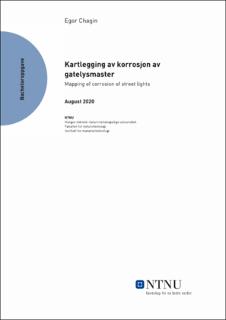| dc.contributor.advisor | Andresen, Bjørn | |
| dc.contributor.advisor | Mørkve, Marte Sørtveit | |
| dc.contributor.author | Chagin, Egor | |
| dc.date.accessioned | 2021-09-28T18:14:40Z | |
| dc.date.available | 2021-09-28T18:14:40Z | |
| dc.date.issued | 2020 | |
| dc.identifier | no.ntnu:inspera:58667261:58668154 | |
| dc.identifier.uri | https://hdl.handle.net/11250/2785295 | |
| dc.description.abstract | Bakgrunn med dette oppgave er at i dag er det situasjonen med lysmastene i Trondheim er ut av kontrollen – vanskelig å oppdage korrosjon, og bestemme hvilke faktorer som påvirker. Dette skjedd på grunn av de siste 40 år teknologisk progress vokst opp, de nye teknologiske løsninger kommer i brukt, samt med de gamle. På grunn av det, vedlikeholdet kan ikke gjennomføres i sammen tiden med alle lysmaster. Dette skjer på grunn av forskjellige lyktestolper har forskjellig korrosjonsraten.
Denne oppgaven har som hensikt å finne ut hvilke faktorer som kan påvirke korrosjon i lysmaster i Trondheim kommune, finne ut tendenser gjennom forskjellige byområder og lage noen forslag til å forbedre situasjonen.
Data ble samlet ved hjelp av ultralyd testen. UT-testen ble valgt på grunn av det er mest nøyaktig måte å analysere metallkonstruksjoner utendørs.
Dataanalysen ble gjennomført på grunn av de innsamlede data, noen karakteristiske trekk ble bestemt ifølge kvantitativt og kvalitativt analysen av resultat til eksperimentell del av arbeidet.
Ut ifra data som ble bearbeidet, ble det bestemt at det farligste korrosjonstypen til lysmastene er uniform og våt korrosjon. Det beste måte å beskytte metallkonstruksjoner i bymiljøet på er galvanisering. Naturlige faktorer påvirker nesten ikke korrosjonen, de teknologiske faktorer spiller mye større rolle.
Konklusjon: Det anbefales å erstatte gamle mastene til de galvaniserte eller delvis galvaniserte. Sterk anbefales å unngå å sette lysmastene direkte i sand/grus, mye bedre å bruke fundament. I tillegg det blir mye enklere å ta kontroll over det, hvis det blir mer dokumentasjon om lysmastene samlet inn i systemet for å planlegge vedlikeholdet bedre. | |
| dc.description.abstract | The reason for this task is as a nowadays situation with the streetlights in Trondheim is out of control - difficult to detect corrosion, and determine which factors affect. This happened due to the last 40 years technological progress has grown up, the new technological solutions are coming into use as well as with the old ones in the same time. Due to that, the maintenance cannot be carried out in the same time with all the light poles. This happens because different lampposts have different reactions to corrosion.
This project aims to find out what factors can affect corrosion in streetlights in Trondheim municipality, find out trends through different urban areas and make some suggestions to improve the situation to better future.
Data were collected using the ultrasound test. The UT test was chosen because it is the most accurate way to analyse metal structures outdoors.
The data analysis was carried out due to the collected data, some characteristic features were determined according to the quantitative and qualitative analysis of the result of the experimental part of the work.
Based on the data that was processed, it was decided that the most dangerous type of corrosion for the streetlights are uniform- and wet corrosion. The best way to protect metal structures in the urban environment is galvanizing. Natural factors hardly affect corrosion, the technological factors play a much bigger role.
Conclusion: It is recommended to replace old streetlights with galvanized or partially galvanized ones. It is strongly recommended to avoid placing the light poles directly in sand / gravel, much better to use a modern foundation. In addition, it will be much easier to take control of it, if there is more documentation about the light masts collected in the system to plan maintenance better. | |
| dc.language | | |
| dc.publisher | NTNU | |
| dc.title | Kartlegging av korrosjon av gatelysmaster | |
| dc.type | Bachelor thesis | |
